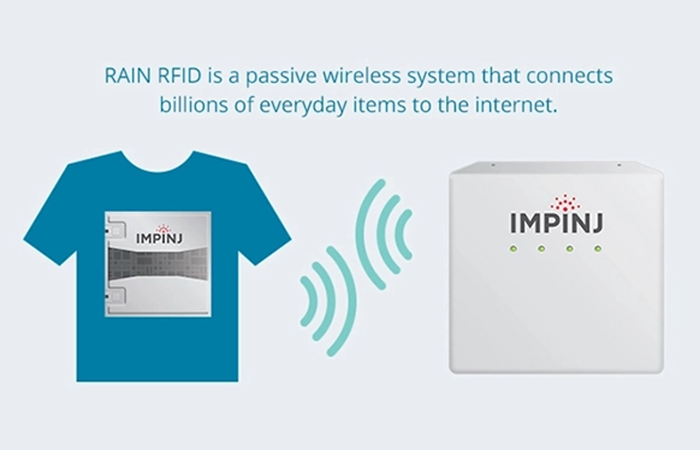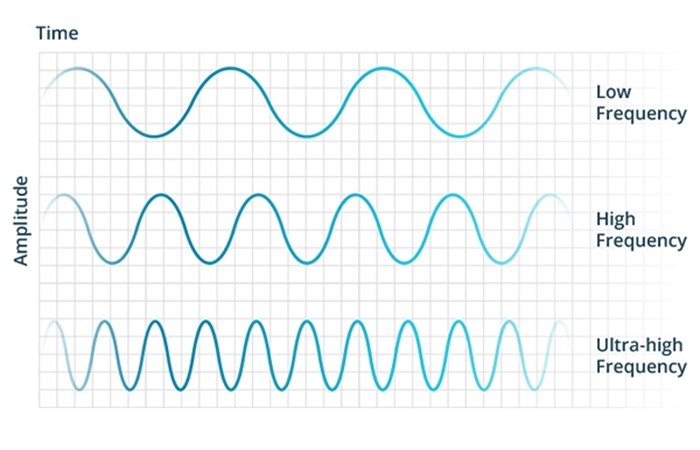UHF RFID and RAIN RFID: What's the Difference?
Chances are, you’ve heard the terms UHF and RAIN used interchangeably in conversations about RFID. Find out how these terms are similar — and what sets them apart.
The tech world is no stranger to acronyms and unfamiliar terms, and the field of radio frequency identification (RFID) is no exception. If you’re familiar with RFID technology, you may have heard “UHF” mentioned in the same breath as “RAIN RFID.” What do these letters mean, and how are the technologies similar or different?

RFID is a generic term that encompasses different operating frequencies and standards. UHF, which stands for “ultra-high frequency,” is a frequency band that covers the range from 300 MHz to 3 GHz. RAIN RFID devices operate within the UHF band (between 860 to 960 MHz) and align with a specific standard and protocol. Impinj products such as RAIN RFID tag chips, reader chips, and readers align with this standard and are interoperable with other compliant products.
What's the difference between UHF RFID and RAIN RFID?
Because RAIN RFID systems operate within the UHF band, RAIN RFID and UHF RFID are essentially referring to the same thing. “RAIN” is a name that brands passive UHF RFID products and technology that adhere to the ISO 18000-63 standard and GS1 EPC UHF Gen 2 protocol, providing a common and recognizable identity in much the same way the terms “Bluetooth” and “Wi-Fi” are used for other technologies.
The RAIN RFID brand name was adopted in 2014 when several companies working with passive UHF RFID technology began to see that the term “RFID” was being used very broadly to represent multiple types of sensor technologies – many of which did not have the same cost-effective, transformational capabilities of passive UHF RFID. This created a concern that the expanding use and meaning of the term “RFID” might confuse the market.
At the same time, these companies saw the technology’s growing importance in the enablement of the Internet of Things. The word “RAIN” is intended as a nod to the link between UHF RFID and the cloud, where RFID-based data can be stored, managed, and shared via the internet.
[Want to read more content like this? Check out the Impinj blog and subscribe.]
What is RAIN RFID and what does it do?
RAIN RFID is a passive, battery-free, wireless technology that connects billions of everyday items — from socks to strawberries to shipping pallets — to the internet. It allows businesses and consumers to discover, engage, and protect connected items, and provides access to real-time data and historical insight about those items. This allows the user to know exactly what an item is, where it’s been, where it’s located in a facility, and other insights.
RAIN RFID provides the ability to:
- Uniquely identify individual items beyond just their product type
- Identify and locate items without direct line-of-sight
- Identify many items quickly (up to 1,000 items per second)
- Read items within a range of a few centimeters up to 10 meters
RAIN RFID tags cost pennies, don’t require batteries to communicate, and can be read — or “interrogated” — at short or long range and at high speeds and volumes through most materials such as cartons, boxes, and wood. These unique capabilities make RAIN ideally suited for use on trillions of items, from apparel to pharmaceuticals to food, all along the supply chain.
Many industries use RAIN RFID to identify, locate, and protect the things that matter to people and businesses:
- Aviation: RAIN improves customer service and operational efficiencies with accurate, real-time data about luggage, assets, equipment, and more.
- Healthcare: Streamlines asset tracking, eliminates loss, improves supply management, enhances patient experiences, and drives better outcomes.
- Hospitality: Improves efficiencies, streamlines operations, and strengthens businesses while delivering a superior customer experience.
- Manufacturing: Achieves maximum operational efficiency with automated processes that change the way machines and humans work.
- Retail:Optimizes store operations, improves inventory availability, develops seamless shopping experiences, and collects valuable analytics that drive informed business decisions.
- Supply chain and logistics: Keeps goods moving and operations informed with accurate, automated, and error-free management.

What are the types of RFID?
In addition to UHF RFID, there are two other types of RFID: low-frequency RFID and high-frequency RFID. Frequency refers to the size of the radio waves used to communicate between system components. Radio waves behave differently at each of these frequencies, and there are advantages and disadvantages associated with using each frequency band.
- Low-Frequency (LF) RFID only provides short range (centimeters) and reads one tag at a time. Because of this slower data-read rate, it is often used for access control and pet microchips.
- High-frequency (HF) RFID systems are most often used for data transfer applications, ticketing, and payments.
Is NFC the same as RAIN RFID?
While NFC and RFID have some similarities, they are not the same. NFC stands for “near-field communication,” and is most often specified for applications requiring secure transfer of data. The NFC brand provides differentiation for the Ecma-340, ISO/IEC 18092 standard, which uses a specific version of passive HF RFID.
While RAIN RFID is used to track multiple items from a distance without direct line-of-sight (such as a pallet filled with stacked boxes passing through a warehouse), NFC operates when a device and a reader are within very close range — usually no more than a few centimeters. When you tap your credit card or smartphone on a reader at the grocery store checkout, you’re using NFC.
UHF vs. RAIN in a nutshell
The terms RAIN and UHF are often used interchangeably. Labeling a system as RAIN RFID lets the user know that the system or technology adheres to a specific standard and protocol. The RAIN Alliance is the industry organization supporting the universal adoption of RAIN RFID. The RAIN RFID name and logo may be used by anyone (RAIN Alliance members and nonmembers) on marketing materials.
Today, the majority of new RFID projects are using RAIN RFID. As the fastest-growing segment of the RFID market, with more than 80 billion tag chips sold to date, RAIN RFID is used in many markets and industries worldwide. Check out the many possible uses of RAIN RFID, including inventory management, asset tracking, loss prevention, and supply chain automation.
Learn more about RAIN RFID and the Impinj platform.
- Article tagged as:
Friday, November 4, 2022
ABOUT THE AUTHOR

Jill West
Vice President, Strategic Communications
Jill West leads Impinj IoT technology adoption marketing initiatives across numerous markets including retail, healthcare, and supply chain and logistics.
Sign Up for the latest news
